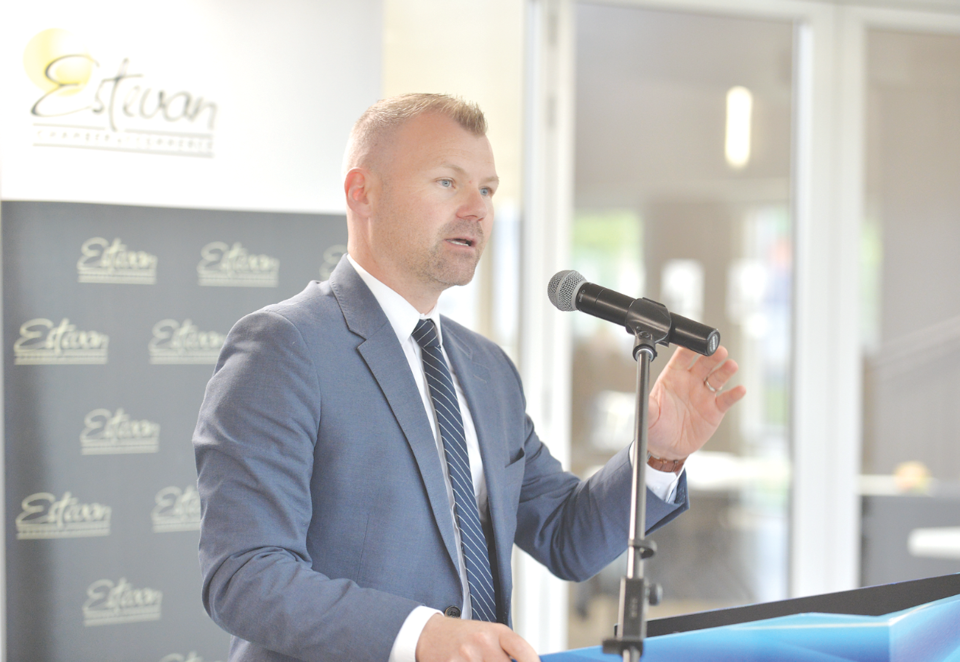Saskatchewan Environment Minister Dustin Duncan had a lot of interest with regards to his luncheon presentation on carbon taxation to the Estevan Chamber of Commerce on June 20. The question and answer period went just about as long as the 20 minute speech, as chamber members brought up numerous concerns, in a community that depends on coal mines and coal-fired power for much of its livelihood.
Carbon dioxide emissions are very much on the mind of the provincial government, with the federal government threatening to impose a carbon tax, and an equivalency agreement which would recognize carbon capture implemented by SaskPower fleetwide, as opposed to individual generating units, still up in the air. Duncan noted, “It is no secret our government will soon have to make a decision on Boundary Dam 4 and 5.”
The carbon capture unit on Boundary Dam Unit 3 went into operation in 2014. The deadline for a decision on the next two units is fast approaching, and if they are kept in operation, there will be fines from the federal government.
Duncan said the decision on Units 4 and 5 would be made this summer.
“You no doubt know that natural gas prices are at historic lows. This makes natural gas an attractive, economical option for future power generation,” Duncan said. “So while we must take these costs into consideration, I assure you that we recognize the value of the coal industry in this community, and the contributions it makes to our economy.”
“That is why we are aggressively pursuing an equivalency agreement with the federal government, a federal government that has already decided that coal must be phased out by 2030,” the minister noted.
An equivalency agreement would give flexibility to keep Boundary Dam Units 4 and 5 operating, otherwise, there would have to be a hard shutdown by the end of 2019.
Even if replaced by natural gas generation, that does not preclude the installation of carbon capture and storage on other facilities such as Shand Power Station. He noted that Shand’s lifespan is projected to 2042, and shutting it down in 2030 would make it a “stranded asset” that has already been paid for, but we could no longer use.
To date, he noted Boundary Dam Unit 3 has captured two million tonnes of carbon dioxide, the equivalent of taking a half million cars off the road.
Duncan said there were 1,600 coal-fired power plants in planning or construction phases around the world, and that China has added 600,000 megawatts of coal-fired power. In Vietnam, there is 4,300 megawatts of coal-fired power being built, all new, all coal, “and none of it has CCS.”
While Canada is on a track to eliminate coal-fired power, he pointed out we have no plans to ban the export of coal, and that last year we exported 36 million tonnes for power and steel production. Since west coast states have not allowed additional coal shipping, American coal is being exported via Vancouver.
Duncan said Canada is responsible for 1.6 per cent of global carbon dioxide emissions, and Saskatchewan is responsible for 10 per cent of that. Reducing our 75 million tonnes of emissions per year to zero would have no impact.
He pointed out that with recent tax cuts in the United States, a carbon tax just might be the final push for competitive capital to go elsewhere.
With regards to a carbon tax on Saskatchewan, Duncan said, “They call it a revenue-neutral tax, an oxymoron if I’ve ever heard one.”
While the federal liberals have said agricultural will be exempt, it will still apply to fuel, and the natural gas used to make fertilizer.
He said the province is taking Ottawa to court on this, noting, “Ottawa is trying to impose this flawed policy on some provinces, but not others. There will be no stopping the federal government at $50 per tonne.”
Duncan touted the Saskatchewan government’s “Prairie Resilience” plan to reduce emissions without a carbon tax, a plan to use green technology to get “real results,” with 11 million tonnes of actual reductions in emissions.
One of the questions from the floor was “What’s Plan B if we can’t get an equivalency agreement?”
Duncan responded that the agreement is taking longer than expected. “The goal posts keep moving, from the federal government.”
“It’s frustrating to say the least.”
Even if they get an equivalency agreement and build carbon capture at a different facility, there is still the need to refurbish BD Units 4 and 5.
He noted the landscape has started to shift on the carbon tax, with Ontario now against it, and Alberta may have a change in government eventually.
“This has never really been about emissions,” Duncan said of the carbon tax, saying it was more about locking in policy decisions, regardless of the province.
He concluded saying, “We’re dealing with people who just don’t want to see coal used in the future.”



